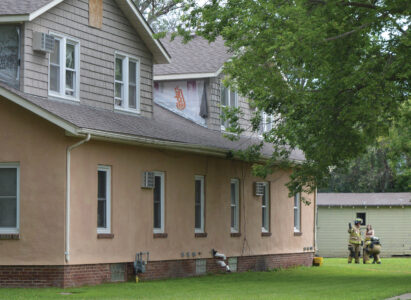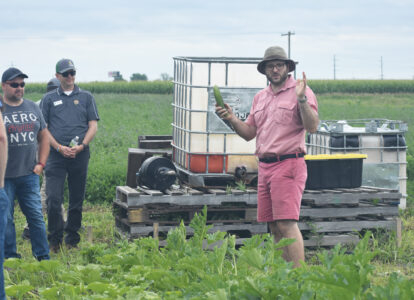The science behind rotational grazing
Thooft, a third-generation farmer, connects grazers with mentors through Minnesota Grazing Lands Conservation Association

Photo by Jim Tate Scott Thooft holds a tillage radish that is in the cover crop mix on his farm. The mix also includes turnips, common vetch, flax and oats.
“Farmers like to talk to farmers.”
That simple statement is a big reason for the steady growth of the Minnesota Grazing Lands Conservation Association (MNGLCA), a state-wide group whose goal is to promote sustainable ranching through education, and connecting grazers with mentors.
Its state vice president is Scott Thooft, who farms on the third-generation family farm north of Lynd. His wife, Debbie is the group’s treasurer.
“It’s a national group, there’s 24 states that have one,” said Debbie Thooft. “Minnesota’s started in 2010, when it became a non-profit, though there were activities before that.”
On the surface, grazing may seem fairly simple — let the animals out into a pasture area and let them eat. That’s hardly the case. There’s a lot of best-practices and agricultural science behind what the group does and there’s annual schools and seminars held to better educate those wishing to learn more.
Thooft practices rotational grazing on his operation, which includes 120 cows. “That includes any number of paddocks, or pastures. It allows the other paddocks an opportunity to rest,” he said.
Thooft has a total of 10 pastures that occupy 250 acres of his 440-acre grazing operation. He also has a hog operation, and grows corn, soybeans and alfalfa.
He became interested in the nuances of grazing from his father, Ernest.
“He was ahead of his time as far as grazing,” said Thooft.
A friend invited him to a national grazing conference in St. Louis years ago, and through that experience he became involved with state leadership over time. He’s a past state president of the MNGLCA.
Having water available to livestock is an important part of the operation. Thooft received a grant through the USDA National Resources Conservation Service that allowed him to run two miles of water line through his pastures. He custom made watering tanks from old scraper tires to put at key locations.
“Each holds about 1,000 gallons. I tend to overdue things, I like to just do it once. I’ve got seven of them, and they are placed in the fence lines connecting the paddocks, he said.
Education is a huge part of the mission of the MNGLCA, and each year there’s many opportunities to learn about the group, grazing practices, soil health, as well as have the opportunity to network with others, another key part of the group’s mission and end-goal.
There’s the Midwest Grazing & Soil Health Summit March 19-20 in Willmar, held in conjunction with the Sustainable Farming Association. From March 25-April 3 is a series of presentations throughout the state on he topic “Roots and Rotation: Integrating Soil Health Principles Into Grazing Practices, held in conjunction with the USDA Natural Resources Conservation Services which will be in Canby April 3.
On July 29-30, there’s a GrazeHERs School, a women-led conference dedicated to advancing sustainable agriculture and grazing, from more of a female perspective, and also coming up July 22-23 there will be a Grazing School near Pipestone.
Many of those new to grazing practices enjoy the Pasture Walks, a walking tour held at various farms with long-standing successful grazing practices.
“It’s an opportunity to ask questions,” said Thooft.
These educational opportunities are held throughout the state, and either presented by the GLCA or held in conjunction with other like-minded groups.
“That helps to stretch the budget, and we can reach more individuals as far as what we are trying to do,” said Thooft.
They work with others such Soil and Water Conservation Districts, Minnesota Soil Health Coalition, Sustainable Farming Association, Ducks Unlimited and Pheasants Forever, to name a few.
“We work together, otherwise you’re just stepping on each other’s toes,” he said.
Matching those newly-interested in the practice with those more experienced is the mentor part of the group’s mission.
“Those people learn from those who do it,” said Thooft.
“That mentor relationship can be nearby, or far away. lf there’s an interest, there’s a mentor,” he said.
There’s also Grazing Schools, where participants can learn about such things as cold and warm season grasses, species of plants, fencing, infrastructure, nutrition, and more.
The group deals with all animals who graze, not just cattle. “More people are now grazing sheep and goats, even chickens. There’s a lot of interest out there for those who live on smaller hobby farms,” said Debbie Thooft.
There’s all types of grasses out there, and the grazing schools help break down the many options available. Producer panels are a part of presentations, and they are an important aspect — “Those are very popular. Farmers like to talk to farmers,” said Scott Thooft.
The educational opportunities are held throughout the year, and deal with pertinent topics. Last year, for instance, the group anticipated more drought conditions, and that was an emphasis area.
The educational sessions also look at the bigger picture, such as being wildlife friendly as it relates to nesting seasons.
Scott and Debbie were high school sweethearts at Marshall High School. They’ll be married 33 years in September, and raised four children: Tanner, Taylor, Tara and Tucker. They have one grandchild, Silas, 10 months.
“There’s a lot of educational opportunities available,” said Thooft. “The good thing is that you can pick up one or two small things that will help what you are doing, and can be incorporated into your operation.”
Those wishing more information about the MNGLCA or to register for their events can visit their website at www.mnglca.org.


